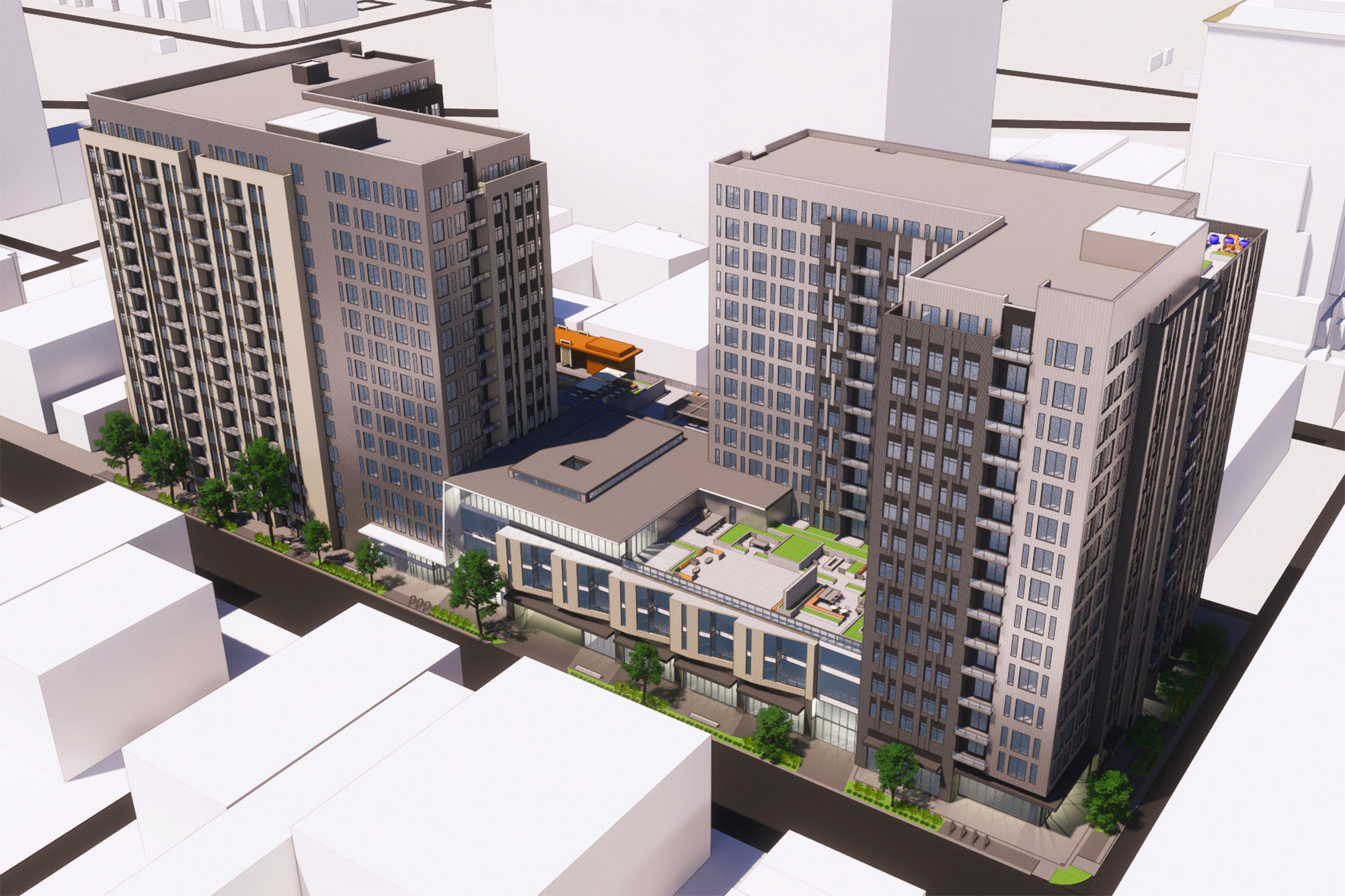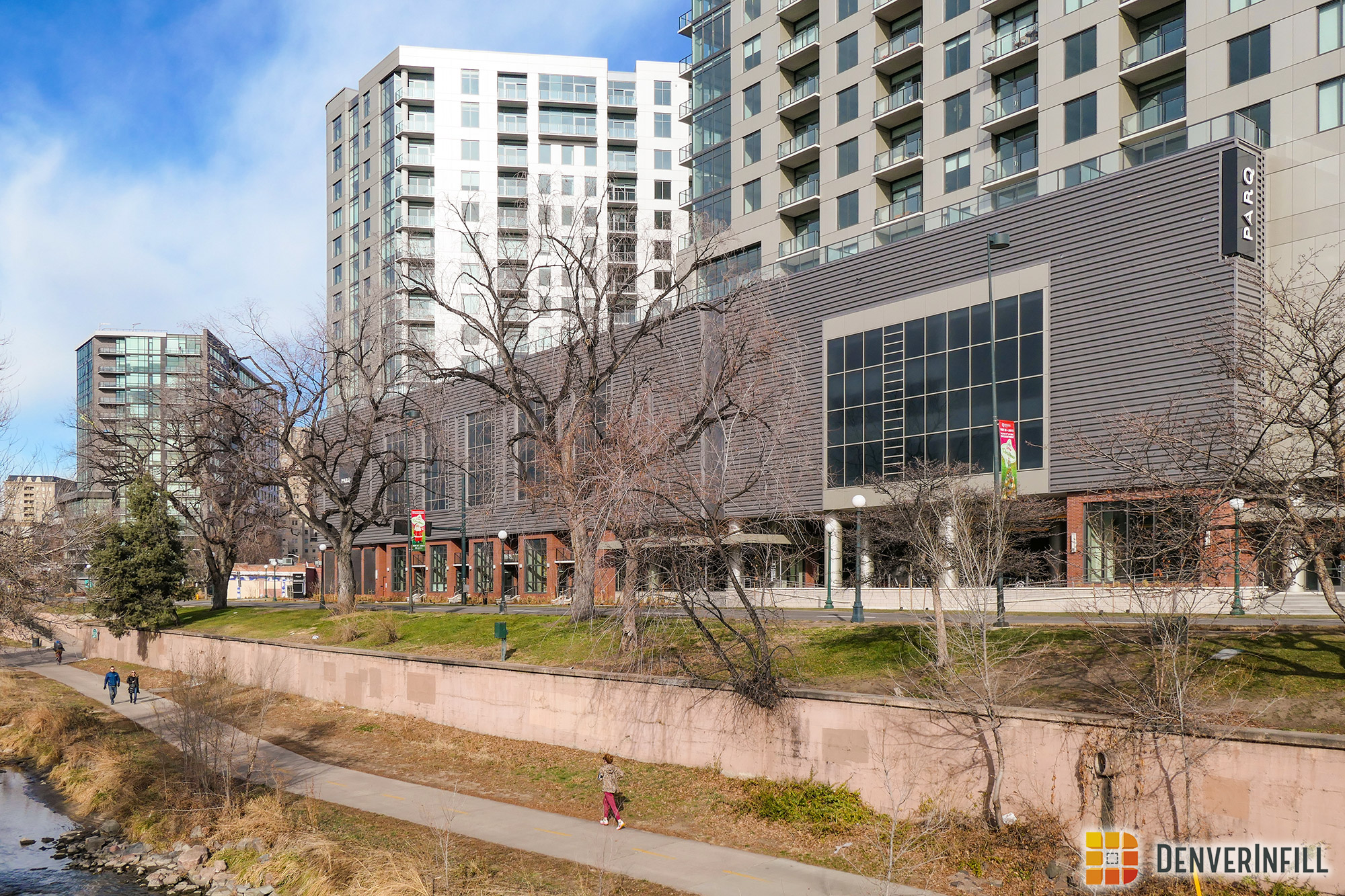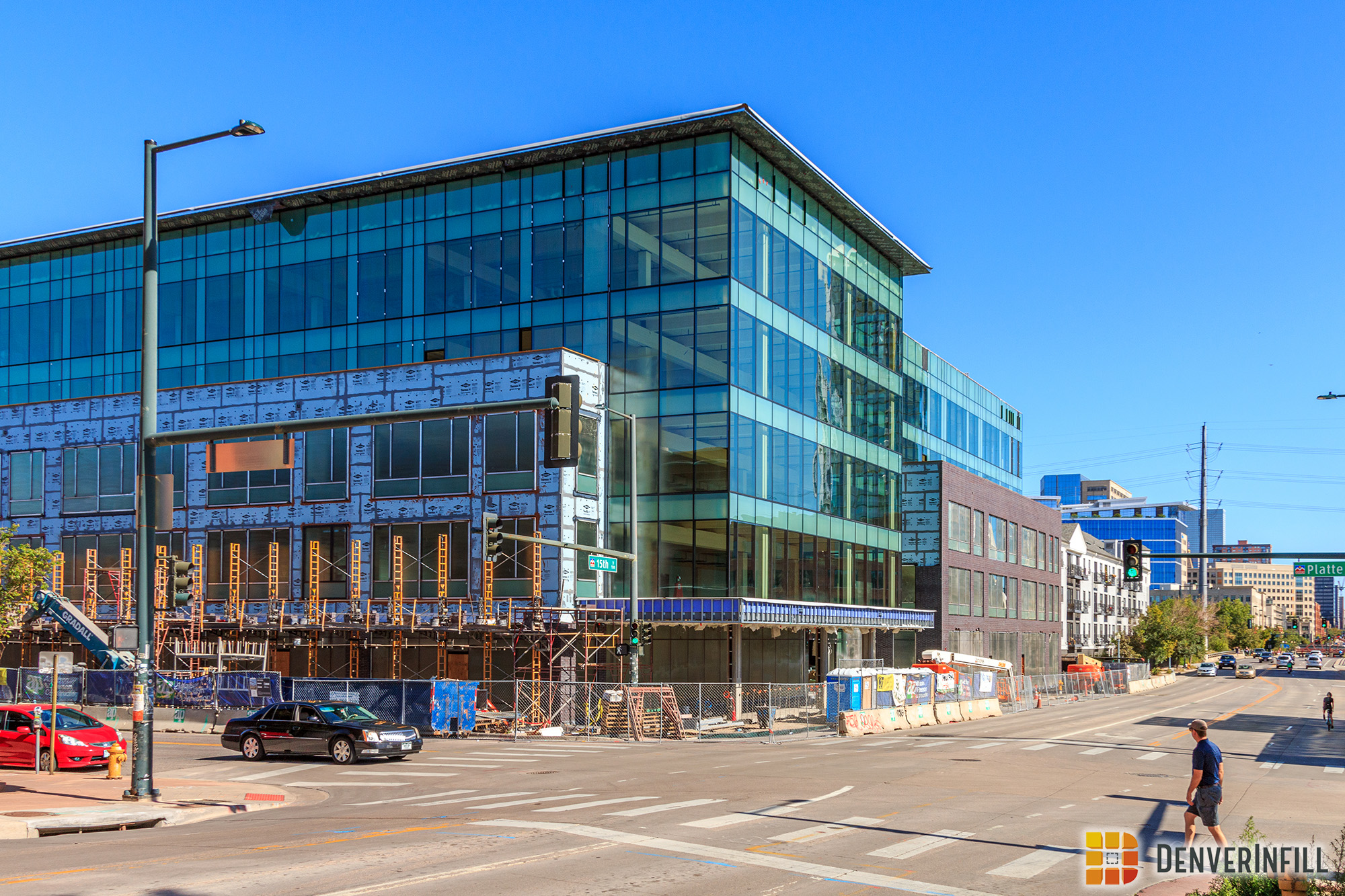Most people familiar with Denver know there is a difference between the names Highland and Highlands to describe the area northwest of Downtown, but I suspect few are very clear as to when to use the one versus the other or if there should be any distinction at all. Even on my DenverInfill maps, I use the name Highland for the entire district, even though I know that’s not entirely accurate. So, in the spirit of civic enlightenment, here’s a brief primer on the difference between Highland and Highlands. My sources for this information are the books Rediscovering Northwest Denver by Ruth Eloise Wiberg and Denver, A Pictorial History by William C. Jones and Kenton Forrest.
The first attempt in establishing a settlement in what is today Denver occurred on September 24, 1858, when some Kansans established the St. Charles Town Association, which claimed the area immediately east of the Platte River and north of Cherry Creek (known today as Lower Downtown). However, they didn’t stick around to actually settle the site; instead, they went back to Kansas to seek a legal town charter from the territorial legislature with plans to return in the Spring of 1859.
Meanwhile, a separate party—from Georgia—established the Auraria Town Company on November 1, 1858 and immediately started building cabins and laying out streets in the area immediately east of the Platte and south of Cherry Creek. Consequently, we will officially celebrate the sesquicentennial of our city’s founding on November 1, 2008, thanks to those Georgians and their settlement named after the town of Auraria, Georgia.
Another party of Kansans, led by General William Larimer, showed up a few days later and unilaterally “assumed” the St. Charles Town Company’s claim and established the town of Denver City on November 17, 1858 in the same area east of the Platte and north of Cherry Creek. (Later, the St. Charles people would return but they failed to assert their claim.) On December 11, 1858, General Larimer waded across the Platte and established on the west side of the river the third town in the area, Highland (without the “s”). Of particular importance to this blog topic is that the western boundary of the town of Highland was Zuni Street (Gallup Avenue at the time).
Among these three towns, not quite one hundred cabins existed that first winter of 1858-1859.
The towns of Auraria and Denver City didn’t get along very well. A rivalry existed as to which town would become the dominant community. Although Auraria had the early lead, thanks in part to the fact that Denver City had the stagecoach station and the only official U.S. Post Office for the three towns, Denver City prevailed. On April 3, 1860, Auraria residents voted to merge with Denver City, and Highland joined in as part of the merger too. The new combined town was named just Denver, and had a population of about 4,700. The area that was once Highland became known within the local government as North Denver, Auraria became West Denver, and Denver City became East Denver.
Over the next decade or so, most of the growth in Denver occurred east of the Platte. But by the mid-1870s, the land to the west of the original town of Highland—i.e. west of Zuni Street—finally caught the attention of a real estate speculator. In the area around what is today W. 32nd Avenue and Federal Boulevard, a new upscale subdivision named Highland Park was platted in 1875 that was modeled after a Scottish village and included curvy streets with names like Argyle, Dunkeld, Caithness, Firth, and Fife. Dozens of additional subdivisions sprang up nearby and later in 1875, the town of Highlands (with an “s”) was established. The eastern boundary for the town of Highlands was Zuni Street (the western boundary for the original Highland), and Highlands eventually extended north to W. 38th Avenue, south to Colfax, and west to Sheridan. Its city hall was located at the corner of 26th and Federal where Denver Fire Station #12 is today.
Highlands was an elite suburb that looked down (literally and figuratively) upon the dirty, crowded, smoggy, crime-ridden city of Denver. Highlands prided itself on its clean air, beautiful gardens and tree-lined streets and, in particular, its high moral standards. Thanks to a fee of $5,000 to obtain a town of Highlands liquor license, there wasn’t a single bar in the entire community. While sinful Denver surged by 1890 to a population of 106,000, affluent clean-living Highlands counted about 8,000 residents.
Denver tried to annex the town of Highlands several times, but Highlands residents always voted against it. Finally, it was their financial state that caused Highlands to give in. The lack of an industrial tax base, a treasury depleted by the Silver Panic of 1893, and a long list of needed infrastructure investments left the town with little choice. On June 22, 1896, the town of Highlands voted to be annexed to Denver.
That’s the story. So what does this mean for us today with regards to the Highland versus Highlands question? I suppose it means that if you are referring specifically to the oldest part of northwest Denver closest to Downtown (east of Zuni Street including the little section of the Downtown street grid west of the river), you should probably call it Highland, and if you are referring to anything west of Zuni, you should probably call it Highlands. Or, call the whole thing Highland and distinguish the part closest to Downtown and the Platte River as Lower Highland. But please, please, whatever you do, just don’t call it “LoHi”!!










Very intriguing post. You should post a listing of your favorite books on Denver history. I would love to know more about the rich history of the city's neighborhoods.
Very interesting. Thanks for the history lesson.
I'm not sure I agree with your conclusion, though. Why call the entire area Highland, sans s?
It seems to me that we basically have three neighborhoods here, all of which include the word "Highland" in their name (Highland, Highland Park, Highlands). In my mind, the logical name for the collective would then be Highlands with an S to indicate plural, as in "more than one Highland". Basically just like the Hamptons on Long Island.
True, but Highlands sounds too much like Highlands Ranch. 🙂
Great post, I have been confused about this for a while now. I wondered why the new walking bridge only had "Highland" inlaid on the north entrance. Also, I couldn't agree more about the term "LoHi" it seems to be a pretty pathetic attempt by the real estate industry to market this area. Thanks for your continued research and willingness to educate those of us who are so interested in the history and future of our city.
Awesome! Great stuff, Ken!
Here's a photo of the Highlands city hall:
http://photoswest.org/cgi-bin/imager?10020661+X-20661
There are a couple more photos of this building hanging in the Denver Firefighters Museum (denverfirefightersmuseum.org/). Amongst, I might add, hundreds of other great Denver photos that don't seem to be a part of the Western History Collection(?).
Auraria, Georgia, (the town Auraria was named after) is now a famous ghost town. Interestingly enough, the Tivoli (in our Auraria) is rumored to be haunted, as multiple paranormal sightings have been reported there.
So here's a burning question I've had for years:
Why is it that city governments don't merge anymore, or why don't city governments try to annex others? It seems like it was once a fairly frequent thing; virtually every major city in the country absorbed its initial ring of suburbs.
Many Denver suburbs would probably benefit from merging with other suburbs; Northglenn has absolutely know room to grow and could potentially merge with either Westminster or Thornton, Wheat Ridge is lacking new development and could merge with Lakewood. The problem I see with that is this: if Northglenn needs to be annexed by another town because its tax base is too poor or its neighorhoods blighted, why would Westminster or Thornton actually want it?
But that begs the question, if Highlands was doing poorly because it had no tax base, why did Denver want it? Why did they want it so bad that they tried to get it long before the city actually agreed to be annexed? Was there something fundamentally different about the way cities and towns operated at back then, to explain why it doesn't happen anymore?
The most glaring example is probably Lakeside Colorado, which has absolutely no room to grow, hardly any residents, a blighted amusement park and defunct shopping mall. Couldn't the city of Arvada, with its considerable resources, do more to turn the area around, save the amusement park (maybe make it historic) and redevelop some of the abandoned buildings?
And why not annex unincorporated land wedged between today's suburbs? One example; there's a big window between the city of Denver and southern Westminster that is unincorporated Adams County. Couldn't this area be better served, with a greater likelihood of infill or redevelopment, if it came under the stewardship of a city government? Or is it, rather, that most cities won't annex it because it would be a sink for resources, demanding more in services than it generates in tax base?
Great post Ken! Thanks
Calm down Pizzuti! These things take time. I do agree with you on Northglenn. Actually, Thornton tried to annex it before Northglenn became a city. The boundries of Metro cities are messy and unusual, compared to the clean boundries of cities in Detroits metro area or the Twin cities. Anyways, Northglenn is doing fine, in my opinion. It has a strong community feel, and good schools, and parks. The "window" north of denver that you are talking about actually has distinct areas: Sherrelwood, Western Hills, Welby, Valley View, Pearl Mack. I happen to live in Sherrelwood. And pretty much every current map of the Metro area includes Sherrelwood and Western hills, giving the impression that they are municipalities, which isnt the case.
Kansans? Hello, it's Kansasians.
Nice story. Of course, if you actually grew up in the "Highlands", it will always be the "North Side".
Excellent history. I have heard several people snootily say it is "Highland", not "Highlands". I guess both are OK. For me personally, I say the Highland neighborhood – as opposed to a ranch.
I will also start calling my particular area "PoHi" – Potter Highland, since that seems to be the hip thing to do…
I just call the whole load "Highlands" or "North Denver". "LoHi" gives me shivers. But then, I've ranted against for letter name contraptions many times on these here comment boards.
I'm originally from Thornton and if I recall, it has tried to annex Northglenn post incorporation as well – they didn't want to be swallowed.
Why would a larger city want a smaller failing city? For the same reasons BOA wanted Merrill Lynch, because they think that with economies of scale they can actually turn the existing tax base into a profitable enterprise. Northglenn does straddle Colorado's most important freeway after all.
It does still happen though – Thornton annexed Eastlake not too long ago.
I want Arapaho Square to be Arsq. That would be hot.
In reference to Pizzuti's post, many cities have absorbed their inner ring suburbs in the distant past (think NYC and its boroughs absorbed around 1898). Denver did the same thing in 1902-04 when it completed its transition into the City and County of Denver. During the late 1890s and upto 1902, the city absorbed the towns of South Denver, Valverde, Barnum, Globeville, Elyria, Berkeley, Highlands, Montclair and Harmon as well as brining in other empty areas of Arapahoe County. There was tremendous controversy over most of these annexations/consolidations, especially from the town of Montclair. But most residents voted in favor of joining Denver as it saved their towns from bankruptcy in some cases, but more importantly, brought these areas into Denver's more reliable water system. Even the town of Fletcher wanted to join Denver but it was too far gone for Denver to pay it any heed. It subsequently renamed itself Aurora and well, you know how that has gone. The towns of Edgewater, Mountain View and Lakeside incorporated after this time and they still exist, although it's sometimes hard to understand why. (Incidentally, Aurora and Edgewater used to be about the same size in area, so you can see the power of annexation. If Edgewater had annexed land as quickly as Aurora did following WWII, we wouldn't be talking about Wheat Ridge or Lakewood today.) At this point, it seems only natural for Edgewater, Lakeside, Mountain View…or any number of suburban cities to join up with a larger Denver. However, this consolidation cannot occur without the action of the state legislature on some level. And any other annexation by Denver, such as the southern stretches of unincorporated Adams County, are constitutionally barred from happening because of the Poundstone Amendment of 1974. Denver can only annex land if a majority of voters in the entire county in which is wishes to annex land approve of the measure. This has only occurred once when Adams County voters approved a 50 square mile annexation by Denver for the new airport. Between 1902 and 1940, Denver annexed no land. Between 1940 and 1974, the city grew to a size of 110 square miles as it mostly annexed former areas of Arapahoe County in the southwest and southeast areas of the city, as well as Montbello and further northeast. When it started annexing into Jefferson County, things got even uglier (The city once stretched all the way to Quicy Avenue near C-470 [Friendly Hill Subdivision for example] but had to return all of that annexed land after numerous court battles). Some scholars feel that the Poundstone Amendment was a racist ploy peddled to state voters who were fearful of Denver annexing its surrounding cities and counties and thus be brought into Denver's court-ordered busing which also began in 1974. Lakewood and Wheat Ridge incorporated only in 1969, partly as a defense against Denver and it's 'predatory' growth. What was once seen as the natural evolution of cities in the 19th century (i.e. consolidation) was seen as predatory by the middle 20th century. It can be argued however that Denver's annexation prohibition forced it to look within instead of at its sprawling periphery and therefore enabled it to work toward recreating the dynamic and improving downtown and central city we have today. Still, does it make sense to have cities such as Lakeside existing or whole pieces of unincorporated Arapahoe County surrounded by Denver (such as Holly Hills). No, it does not. But the political will needed to change this situation and make our local governments more streamlined (or to have a greater metropolitan regional government) will probably take an unprecedented level of commitment, drive and determination that I should think we just do not have.
Great post, Ken. I live in the Scottish Village and didn't know it was really based on a Scottish village.
"LoHi" is a wretched moniker and I think it gets perpetuated by real estate agents mainly. Recently though, the All Tune garage on 29th & Zuni started selling scooters and put up a big, unfortunate sign saying "LoHi Scooters". Thanks, thanks a lot.
Excellent Ken! These are the kinds of things that keep me awake at night. I look forward to more posts on the history of planning and architecture in Denver.
shawn snow said: "Some scholars feel that the Poundstone Amendment was a racist ploy peddled to state voters who were fearful of Denver annexing its surrounding cities and counties and thus be brought into Denver's court-ordered busing which also began in 1974."
I hadn't realized that there had been any controversy as to whether the Poundstone Amendment was anything but a racist ploy.
Great blog, Ken, BTW.
david and snow:
Racist against whom? All I see here are white people. 😛